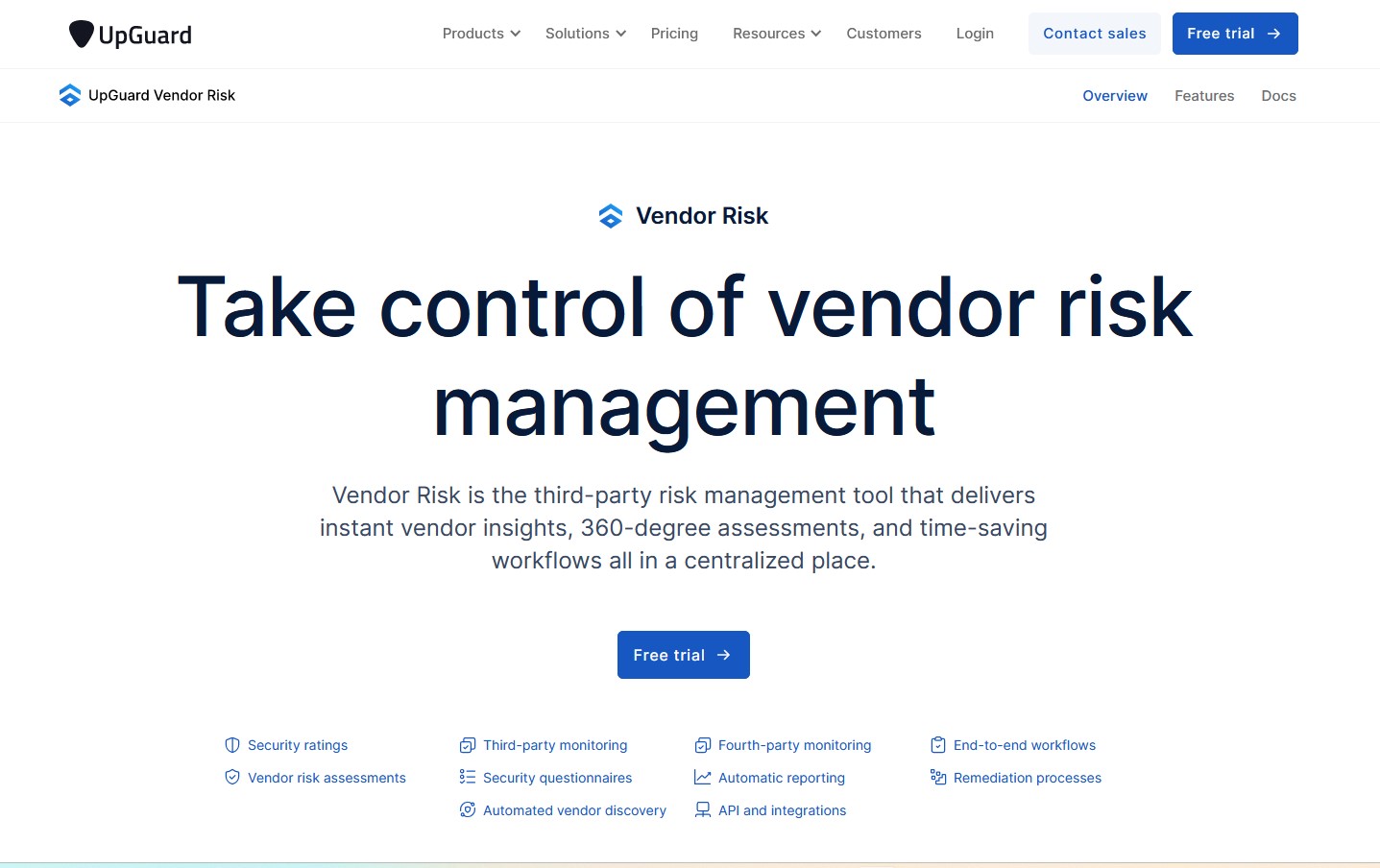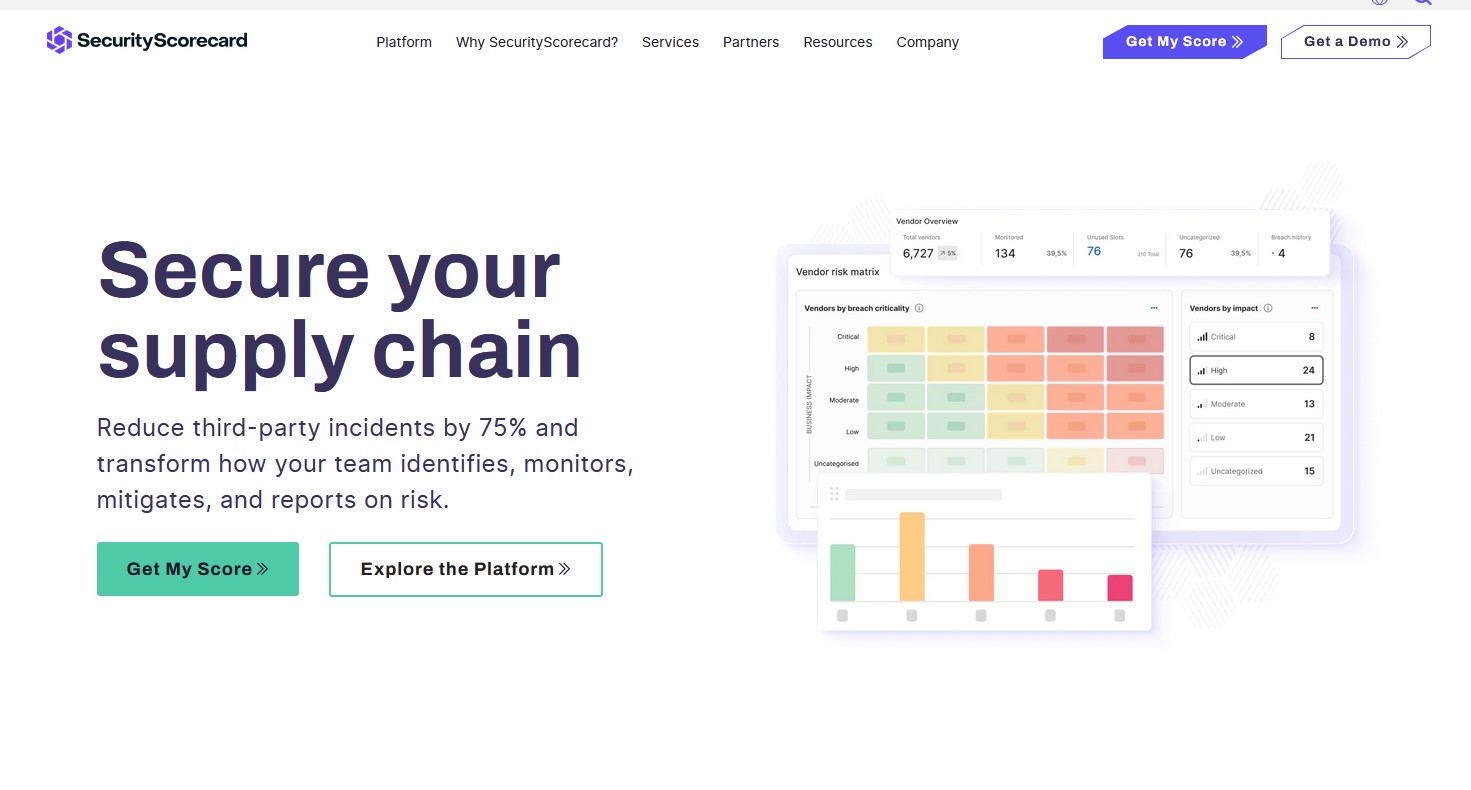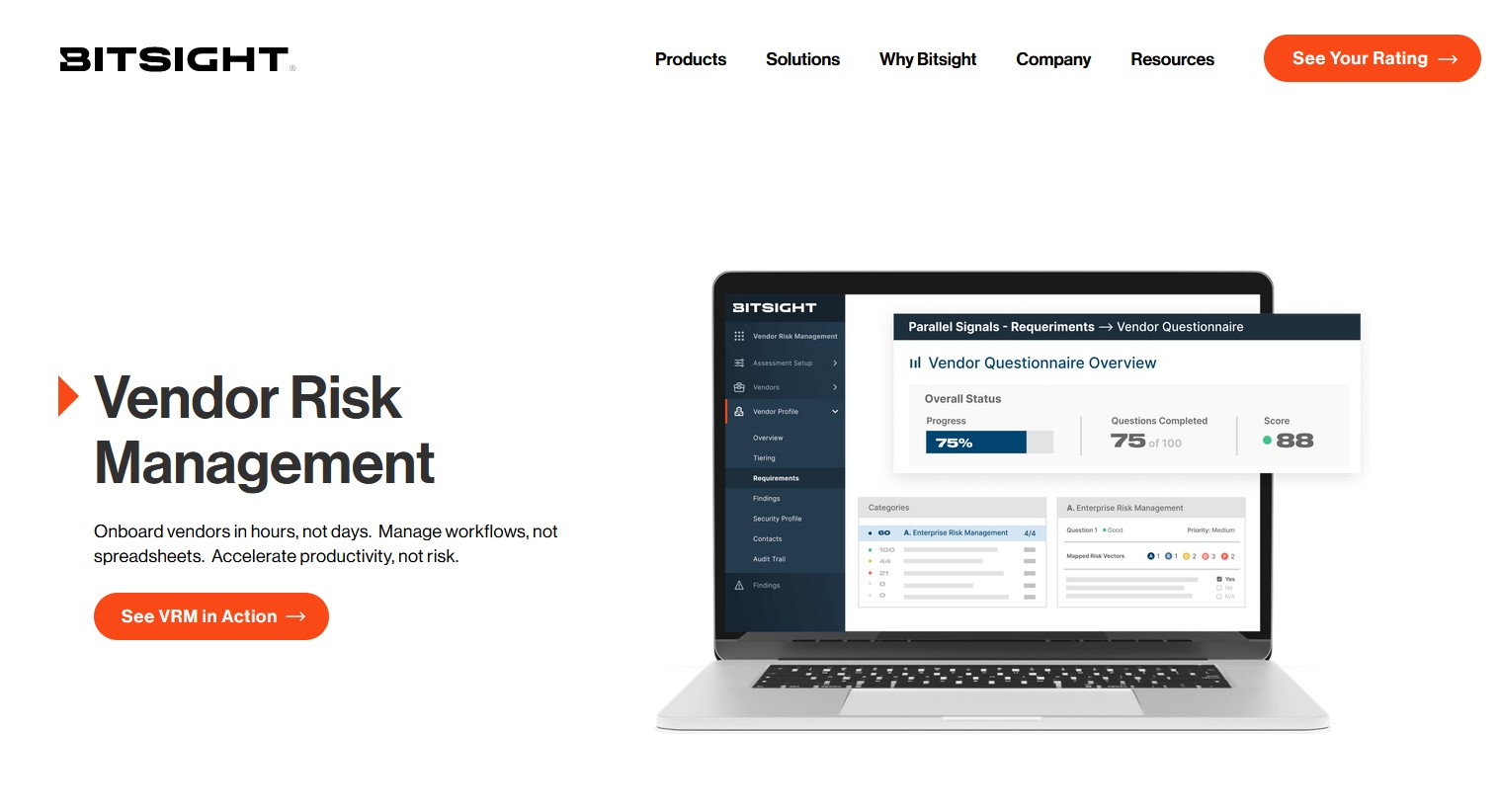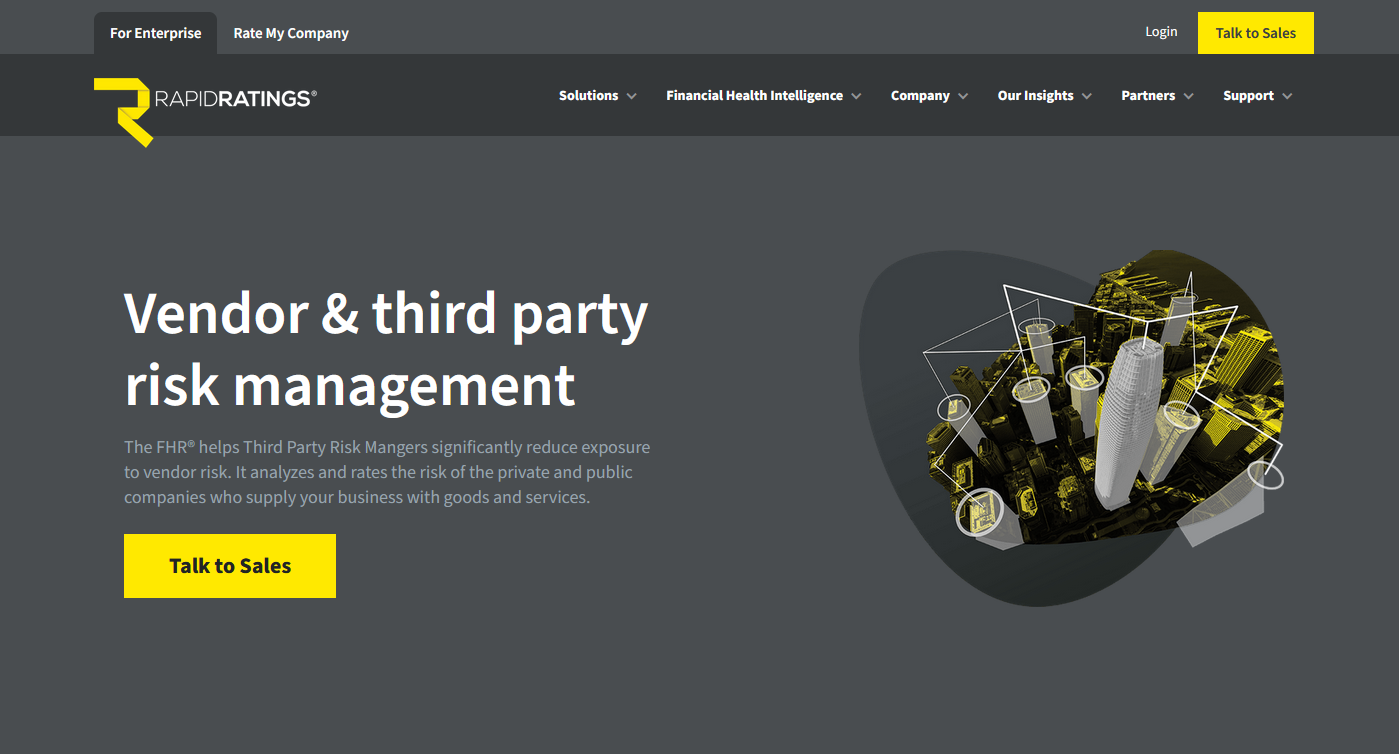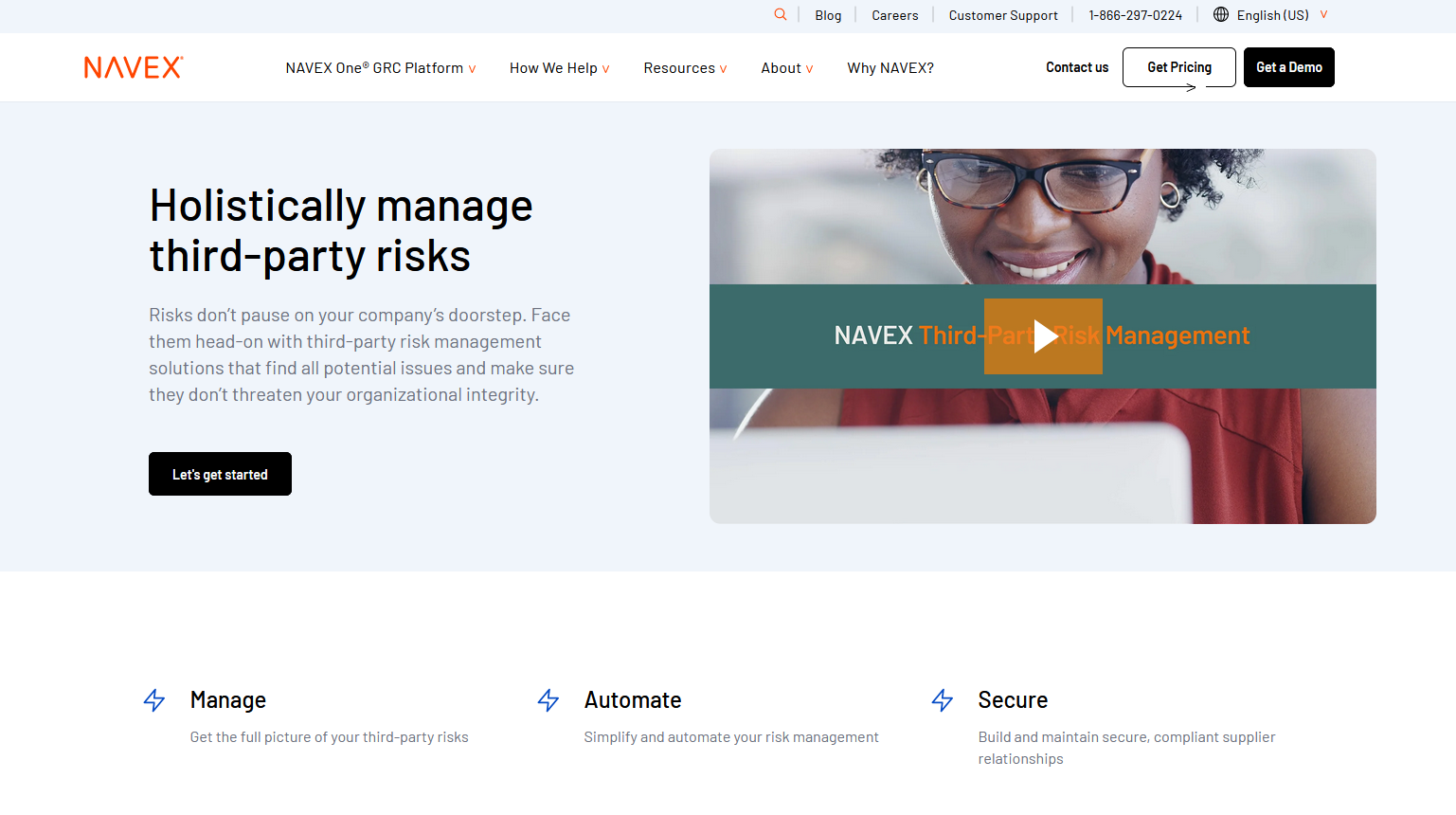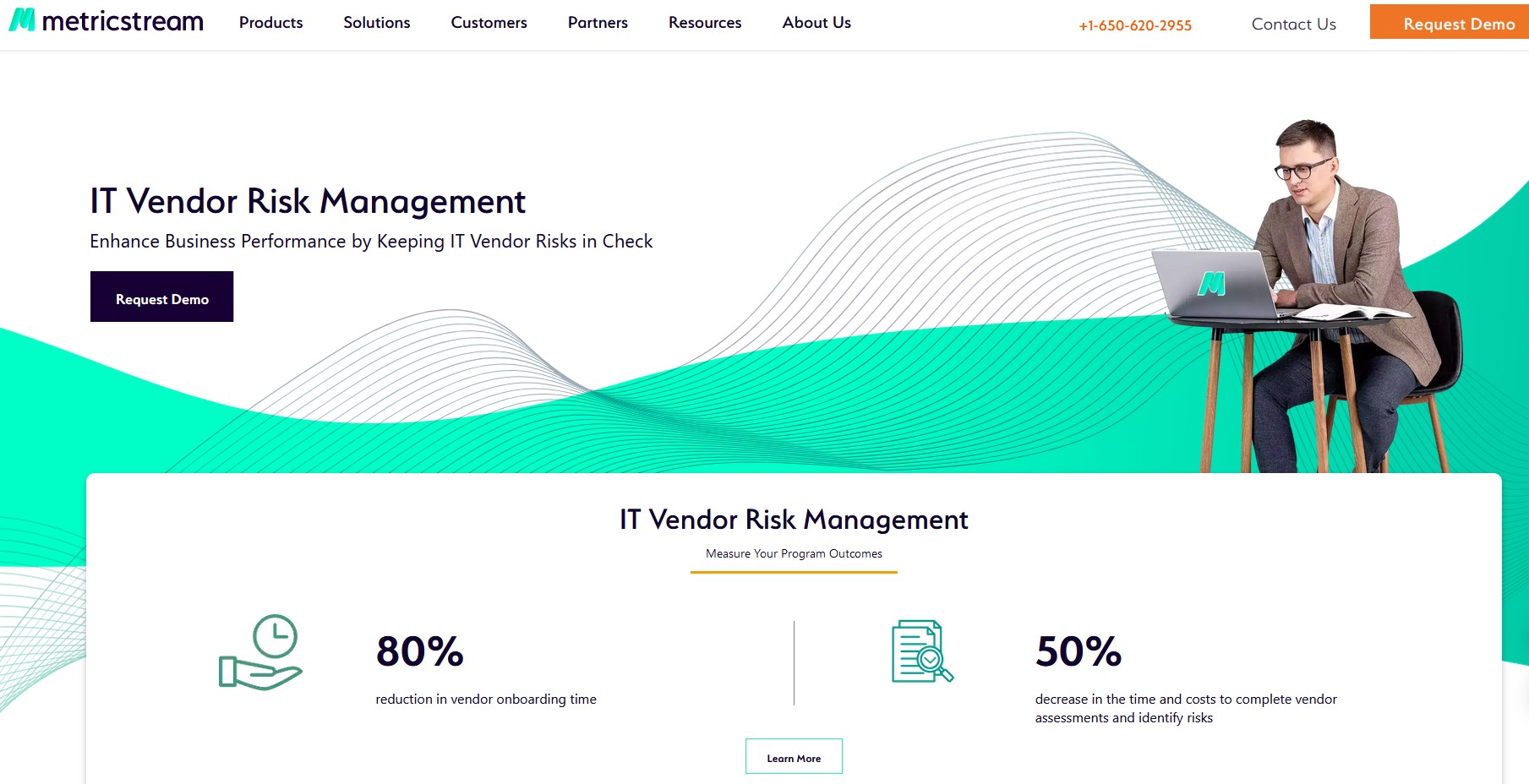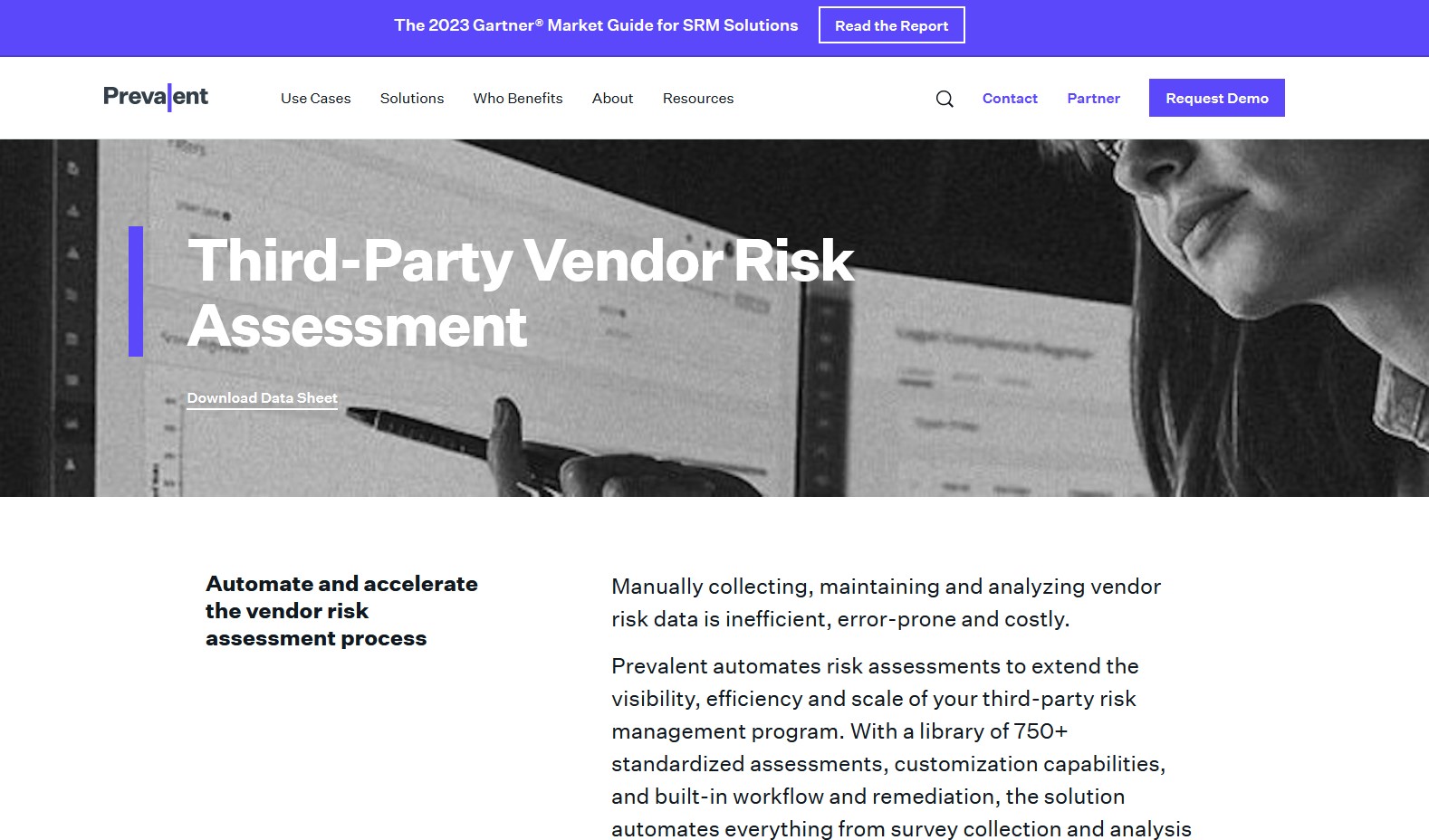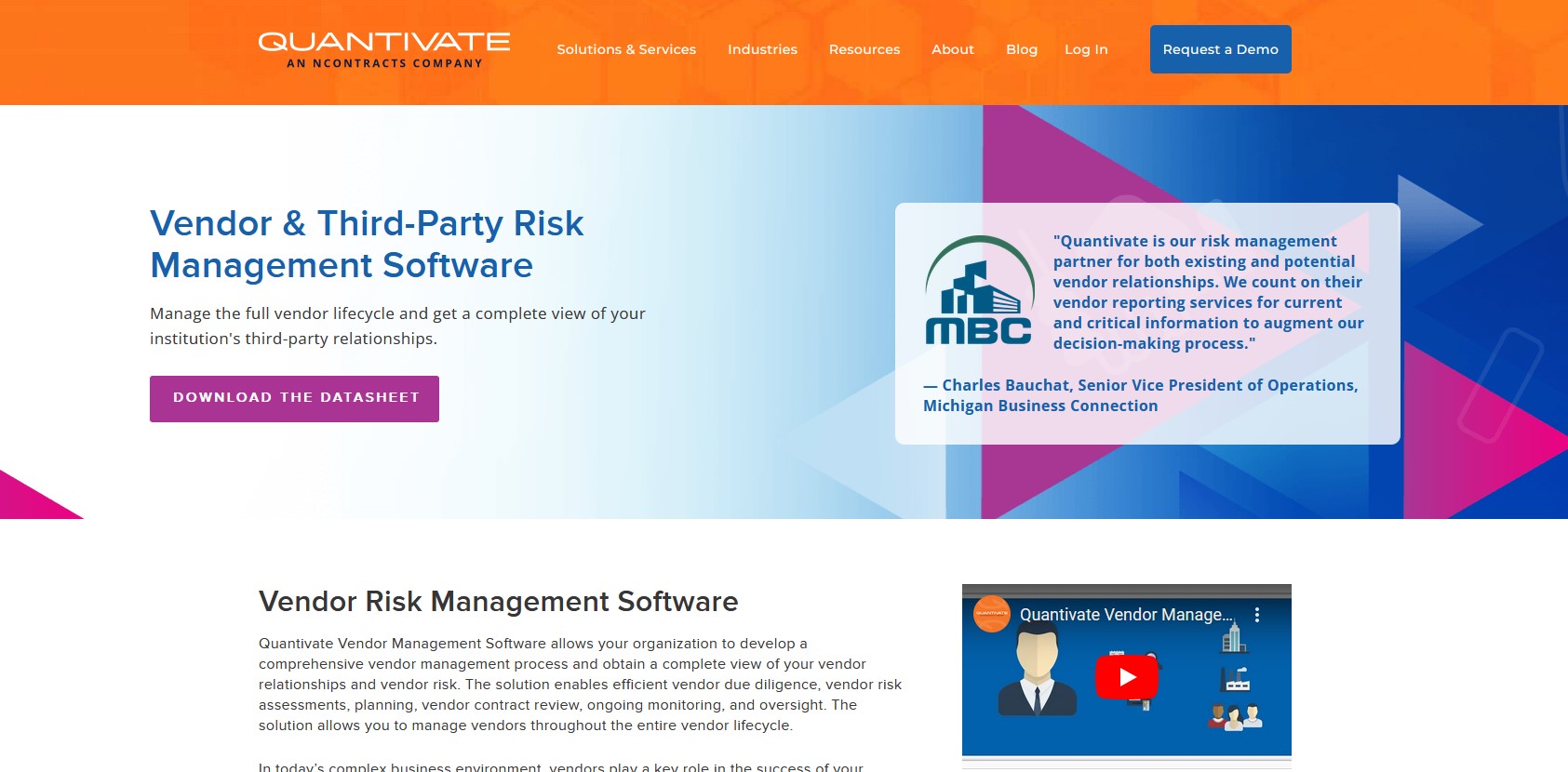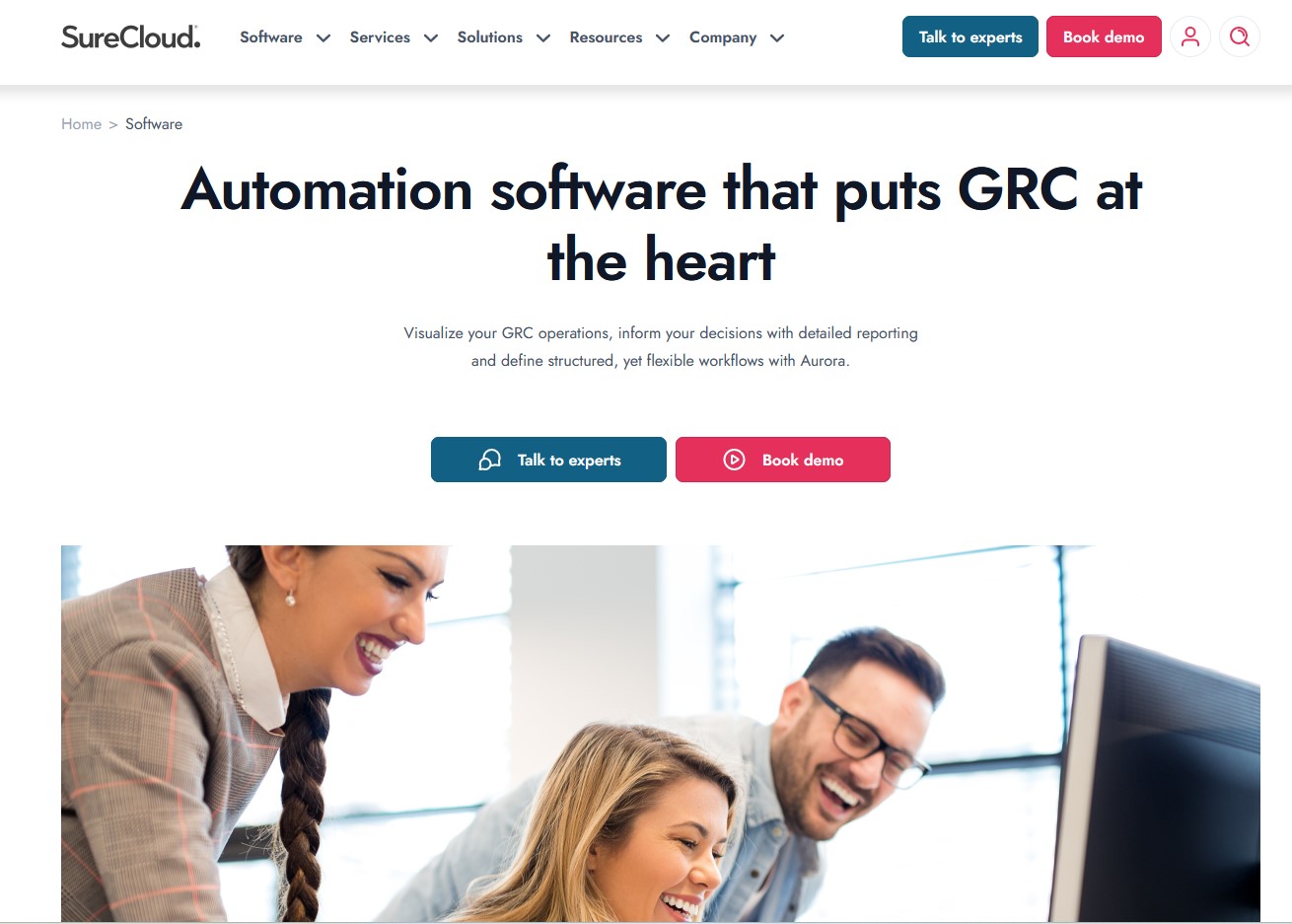High-quality vendor risk management (VRM) entails assessing risk levels across business partners, suppliers, or third-party vendors throughout their life cycle. This includes assessing risks for core business operations, like off-boarding, to mitigate disruptions to business continuity, financial losses, and reputational damage. Effectively managing vendor relationships is vital for businesses with significant supply chain management needs.
Here is our list of the best Vendor Risk Management Tools:
- UpGuard (EDITOR’S PICK): Excels in detecting leaked credentials and exposed data, offering proactive security measures against potential breaches. The tool ensures comprehensive attack surface monitoring and continuous vendor security posture tracking.
- SecurityScorecard: Provides complete visibility into supply chain risks and automates third-party risk management workflows. That said, SecurityScorecard offers detailed reports and a user-friendly interface for effective risk mitigation.
- BitSight: A comprehensive suite of cybersecurity features and a streamlined vendor onboarding process. Some feedback states that user-friendliness is lacking. BitSight’s solutions enhance cybersecurity management and operational efficiency.
- RapidRatings: Provides robust financial health ratings for vendors, facilitating informed decision-making.
- NAVEX IRM (formerly Lockpath): Fully customizable solution for GRC management needs, particularly for vendor risk management. Some intuitiveness issues reported by users. NAVEX IRM’s adaptability and robust reporting capabilities are ideal for organizations across industries.
- MetricStream (DEMO): Ιntegrated risk management and GRC solutions, including vendor risk management, with real-time monitoring capabilities. Some reports of usability challenges. MetricStream provides valuable features for streamlining risk management processes.
- Prevalent: Specializes in third-party risk management solutions, offering customizable assessments and insights into vendor security postures. Some limitations in service ticket resolution, Prevalent’s hands-on support ensures effective vendor risk management.
- Quantivate Vendor Management: Caters to financial institutions seeking comprehensive vendor management solutions. Quantivate offers robust risk assessment capabilities, ideal for organizations prioritizing risk and compliance.
- Aravo: Scalable platform for managing vendor risks effectively. Costs more than many competitors offering similar tools. Aravo provides detailed insights and proactive risk management capabilities that are suitable across industries.
- SureCloud: Cloud-based Integrated GRC products, including vendor risk management, with a focus on simplicity. Despite some limitations in dynamic configuration, SureCloud’s highly configurable platform ensures immediate and sustained value for organizations seeking comprehensive risk management solutions.
Why are Vendor Risk Management tools important?
Clear vendor guidelines are essential in today’s interconnected global supply chains, where data exchange is prevalent. One often overlooked aspect of effective VRM is gaining insight into your vendor’s cybersecurity framework, which is pivotal for safeguarding data assets. Understanding the robustness of a vendor’s cybersecurity posture allows you to assess the efficacy of their data protection strategies and ensure comprehensive risk management practices.
With customizable features, robust reporting capabilities, and user-friendly interfaces, these vendor risk management tools offer valuable resources for organizations across industries. Investing in the right tools and practices enables businesses to enhance their cybersecurity posture, minimize risks, and foster trust and resilience in their vendor relationships.
The Best Vendor Risk Management tools
Here are the best vendor risk management tools.
1. UpGuard (EDITOR’S CHOICE)
UpGuard’s Vendor Risk tool stands out with its unparalleled capability to detect leaked credentials and exposed data, offering proactive security measures to safeguard against potential data breaches. UpGuard Vendor Risk is a third and fourth-party security ratings platform that lets you rate, understand, and continuously monitor the security posture and risk of any company in the world, similar to measuring credit risk with credit ratings.
Key Features:
- Comprehensive attack surface monitoring
- Security questionnaire automation
- Risk remediation workflows
- Regulatory compliance tracking
- Built-in cybersecurity reporting workflows
- Third and fourth-party security ratings
- Continuous monitoring of vendor security posture
- Data leak detection engine
Reasons We Recommend UpGuard:
UpGuard stands out to me, even compared to all the other great tools on this list, for its comprehensive cybersecurity features, user-friendly interface, and robust customer support.
With accurate risk scoring mechanisms and proactive data leak detection capabilities, UpGuard offers a holistic solution for organizations to manage vendor risk, monitor their security posture, and ensure regulatory compliance. Its continuous monitoring ensures timely identification and remediation of vulnerabilities, making it a reliable choice for businesses prioritizing effective security management.
Who We Recommend UpGuard To:
UpGuard is ideal for organizations across industries seeking a reliable cybersecurity platform with comprehensive features and strong customer support. It’s particularly beneficial for businesses prioritizing accurate risk assessment, proactive security measures, and continuous monitoring of their security posture. Whether you’re managing vendor relationships, ensuring compliance, or safeguarding against data breaches, UpGuard provides scalable solutions tailored to your security needs.
Pros:
- User-friendly design
- Strong customer support
- Accurate risk scoring mechanisms
- Ability to detect leaked credentials and exposed data quickly
- Continuous monitoring capability
- Scalable security questionnaire assessment process
- Request remediation for third-party vendors
- Proactive sharing of vendor security posture information
Cons:
- Missing bulk/mass vendor reporting feature
- Pricing model may make it expensive overall
- Limited customization in reporting
- Complexity and learning curve for users
- Required to buy licenses for staff to access reviews
- Amount of information provided can be overwhelming
Pricing:
UpGuard offers flexible pricing plans tailored to your needs:
Basic: $5,999/yr
- Unlimited domains
- Security ratings
- Vulnerability detection
- Executive reporting
- 1 user
Starter: $18,999/yr
- All Basic features
- 50 vendors
- Vendor security ratings
- Risk assessments & questionnaires
- Typosquatting and identity breaches
- 3 users
Professional: $39,999/yr
- All Starter features
- 150 vendors
- Custom co-branding
- Templates & automated vendor classification
- Audit log
- 6 users
Corporate: $89,999/yr
- All Professional features
- 500 vendors
- Data leak detection
- Fourth-party risk
- 10 users
Enterprise: Contact UpGuard for more information
- Unlimited vendors
- Unlimited data leak detection
- Subsidiary monitoring
- Designated support
- 30 users
2. SecurityScorecard
SecurityScorecard’s vendor risk tool provides complete visibility into supply chain risks, automating third-party risk management workflows, and facilitating collaboration to build a secure supply chain. The tool offers detailed reports and a user-friendly interface for effective risk mitigation. Concerns about false positives have been raised by reviewers across several aggregated review platforms.
Key Features:
- Attack surface monitoring
- Vendor risk assessment management
- Security questionnaire automation
- Risk remediation workflows
- Regulatory compliance tracking
- Vendor security posture tracking
- Cybersecurity reporting workflows
- Continuous monitoring of third-party risk
Reasons We Recommend SecurityScorecard:
I found that with a comprehensive suite of features, SecurityScorecard effectively mitigates third-party cyber risks. Despite drawbacks, its detailed reports and user-friendly interface make it invaluable for securing supply chains.
Who We Recommend SecurityScorecard To:
Ideal for organizations enhancing vendor risk management, SecurityScorecard suits security teams navigating evolving cyber threats.
Pros:
- Detailed reports on a company’s cyber reputation
- Easy-to-use interface and vendor search functionality
- Monitors a wide range of categories
- Effective notifications and email alerts
- Informative UI, dashboards, and reports for high-level comparisons and presentations
Cons:
- Concerns about false positives and limited risk detail
- Slow remediation item resolution and score improvement
- Limited integration with SIEM tools like Splunk
- Scoring system lacks customization options
- Pricing structure is piecemeal, lacking an all-inclusive option
Pricing:
Costs for SecurityScorecard start with an entry fee of about $20,000. There are additional per-user costs to consider.
3. BitSight
BitSight offers a comprehensive suite of cybersecurity features and a streamlined vendor onboarding process. Despite some concerns about user-friendliness, BitSight’s solutions enhance cybersecurity management and operational efficiency.
Key Features:
- Attack surface monitoring
- Vendor risk assessment management
- Security questionnaire automation
- Risk remediation workflows
- Vendor security posture tracking
- Cybersecurity reporting workflows
Reasons We Recommend BitSight:
We recommend BitSight for its comprehensive suite of cybersecurity features, streamlined vendor onboarding process, and customizable risk assessment capabilities. I determined that despite concerns about user-friendliness and risk scoring accuracy, BitSight’s solutions offer tangible benefits in enhancing cybersecurity management and operational efficiency.
Who We Recommend BitSight To:
We recommend BitSight to organizations committed to mitigating vendor-related cybersecurity risks and enhancing overall cybersecurity posture. It is an ideal choice for businesses seeking efficient vendor risk management solutions that combine automation with objective data evaluation, enabling strategic decision-making and increased efficiency throughout the vendor lifecycle.
Pros:
- Reporting is suitable for both board-level consumption and engineering planning, providing valuable insights for decision-making.
- Flexible access to data and customizable alerting capabilities enhance operational efficiency.
- Ratings overview offers a quick snapshot of company status, facilitating quick access to detailed information.
Cons:
- Configuration issues persist in records for 60 days, even after resolution, potentially affecting accuracy.
- Limited updates on ongoing threats, particularly ransomware checkpoints, may impact risk assessment effectiveness.
- Occasional reports of false positives undermine confidence in risk scoring accuracy.
Pricing:
The pricing reportedly begins at $20,000, with an additional $2,000 to $2,500 per vendor per year.
4. RapidRatings
RapidRatings provides robust financial health ratings for vendors, facilitating informed decision-making. RapidRatings is not a Nationally Recognized Statistical Rating Agency (NRSRO). The tools do offer comprehensive insights into global financial health, aiding proactive risk mitigation.
Key Features:
- Financial Health Ratings (FHR) on a 0 – 100 scale
- Utilizes fundamental data from financial statements for analysis
- Over 70 efficiency ratios used for evaluation
- Industry-specific risk measurement across 24 industry groupings
- Provides 12-month forward-looking assessments
- Rates both publicly-traded and privately-owned firms
Reasons We Recommend RapidRatings:
We recommend RapidRatings for its innovative approach to financial analysis, providing comprehensive insights into the financial health of both public and private companies globally. Its forward-looking assessments, industry-specific risk measurements, and proactive risk mitigation capabilities empower organizations to make informed decisions and strengthen business relationships. Additionally, I observed that RapidRatings’ advocacy for rating industry reform reflects its commitment to transparency and accountability, further enhancing its credibility and value proposition.
Who We Recommend RapidRatings To:
We recommend RapidRatings to organizations actively seeking to strengthen their financial risk management strategies and enhance transparency in their business relationships. It is well-suited for companies looking to leverage advanced financial analysis tools to make informed decisions and mitigate risks effectively. RapidRatings is an ideal choice for decision-makers and risk management professionals who prioritize forward-looking assessments and advocate for transparency and accountability in the rating industry.
Pros:
- Comprehensive analysis of financial health for informed decision-making
- Offers transparency and visibility into third-party partners, suppliers, vendors, and customers
- Forward-looking assessment aids in proactive risk mitigation
- Individual and confidential outreach to private companies ensures rating consistency
- CEO actively advocates for rating industry reform and transparency
Cons:
- Not a Nationally Recognized Statistical Rating Agency (NRSRO) due to concerns about increased liability exposure and operating costs
- Does not incorporate market inputs, analysts’ opinions, or trade payments in ratings
- Limited market recognition compared to established rating agencies like S&P and Moody’s
Pricing:
RapidRatings boasts competitive, subscription based prices – as low as $ 159/ Per Month, Per User. The company relies on subscription income, which sets it apart from other VRM companies in an interesting way.
5. NAVEX IRM (formerly Lockpath)
NAVEX IRM (formerly Lockpath) offers a fully customizable solution for GRC management needs. Some users report occasional interface issues. NAVEX IRM provides robust reporting capabilities and efficient management of GRC tasks.
Key Features:
- Fully customizable solution for GRC management needs
- Flexible platform for vendor risk management and other GRC requirements
- Robust reporting capabilities for metrics and transparency
- Configurable workflows and notifications for centralized risk management
- Aggregates internal and external data points for comprehensive risk visibility
Reasons We Recommend NAVEX IRM:
We recommend NAVEX IRM for its unparalleled flexibility and adaptability in addressing diverse GRC management needs. Its fully customizable features, intuitive interface, and robust reporting capabilities empower organizations to efficiently manage vendor risks and other GRC tasks. I discovered that with excellent customer service and support from Lockpath teams, NAVEX IRM ensures seamless implementation and ongoing assistance for optimized risk management processes.
Who We Recommend NAVEX IRM To:
We recommend NAVEX IRM to organizations seeking a comprehensive solution for vendor risk management and broader GRC requirements. It is well-suited for businesses of all sizes looking to enhance transparency, streamline processes, and improve efficiency in managing GRC tasks. NAVEX IRM is particularly valuable for decision-makers and risk management professionals seeking a user-friendly platform with customizable features and reliable support.
Pros:
- Highly configurable and adaptable platform
- Powerful reporting capabilities for transparency and metrics
- Excellent customer service and support from Lockpath teams
- Intuitive and easy-to-use layout and menus for navigation
- Streamlined and efficient management of GRC tasks, exceptions, and vendors
Cons:
- Occasional lack of intuitiveness in the tool’s interface
- Reporting limitations and challenges with graphic reporting
- Constraints in modifying field parameters once set
- On-premise solution may encounter bugs, impacting speed and functionality
Pricing:
NAVEX IRM offers flexible pricing plans to accommodate various organizational needs. Starting from $2,600 per month for the Team Edition, users can access advanced features tailored to their risk management requirements. The pricing tiers include Team Edition Plus starting at $4,000 per month, Standard starting at $6,500 per month, and Enterprise (pricing available upon request). Additionally, NAVEX IRM offers a 14-day free trial with no credit card required, allowing organizations to explore its capabilities before committing to a subscription.
6. MetricStream
MetricStream specializes in Integrated Risk Management and Governance, Risk, and Compliance (GRC) solutions, including vendor risk management.
Key Features:
- Integrated Risk Management and GRC solutions
- BusinessGRC, CyberGRC, and ESGRC product lines
- Real-time monitoring of risks, controls, and losses
- Structured application for organized risk levels and action plans
Reasons We Recommend MetricStream:
MetricStream offers a wide range of GRC solutions, including robust vendor risk management capabilities. Despite my noticing some usability challenges, it provides valuable features for organizations aiming to streamline risk management processes and enhance compliance efforts. MetricStream’s website boasts an 80% reduction in onboarding time for new vendors, and a 50% decrease in time and costs required to complete supplier risk assessments.
Who We Recommend MetricStream To:
MetricStream caters to organizations seeking comprehensive Integrated Risk Management and GRC solutions. It’s suitable for businesses prioritizing structured risk management practices and real-time monitoring capabilities.
Pros:
- Structured application for clear risk management
- Detailed information for informed decision-making
- Real-time monitoring for agile risk management
- Wide range of GRC solutions offered
- Ability to define risk levels and issues clearly
Cons:
- Limited usability as a brainstorming tool
- Design may not align with real-life practices
- Impractical navigation between views
- Default settings may impose unnecessary restrictions
- Presence of bugs and delays in issue resolution
- Lack of scalability and configurability
Pricing:
Pricing information is not available for MetricStream without first filling out a form and providing a company email.
7. Prevalent
Prevalent specializes in third-party risk management solutions, offering customizable platforms for streamlined vendor review.
Key Features:
- Custom assessments (PCFs) for vendor review
- Integrated business intelligence reporting
- Customizable platform features
- Viewing access to security postures of popular vendors
Reasons We Recommend Prevalent:
Prevalent offers customizable solutions for third-party risk management, simplifying vendor review processes and enhancing overall security postures. Some limitations in service ticket resolution. I noted that Prevalent isn’t extremely transparent about their pricing. Its hands-on support team comes highly regarded.
Who We Recommend Prevalent To:
Prevalent is ideal for organizations seeking customizable third-party risk management solutions. It suits businesses prioritizing streamlined vendor review processes and hands-on support for optimizing security postures.
Pros:
- Custom assessments simplify vendor review
- User-friendly interface with customizable features
- Ability to customize platform features
- Viewing access to popular vendors’ security postures
- Hands-on support and client-focused services
Cons:
- Slow service ticket resolution
- Complex user role management
- Lack of transparency in pricing
- Inability to build or modify assessments without assistance
Pricing:
Prevalent’s vendor risk offering is on the more expensive side – starting at around $15,000 per user/user license.
8. Quantivate Vendor Management
Quantivate Vendor Management caters to financial institutions seeking comprehensive vendor management solutions. Setup can be complex, depending on your main use case.
Key Features:
- Vendor risk assessment and scoring
- Due diligence and vendor onboarding
- Contract management and tracking
- Incident management and response
- Regulatory compliance tracking
Reasons We Recommend Quantivate Vendor Management:
Quantivate Vendor Management offers comprehensive vendor management solutions tailored to the unique needs of financial institutions. I observed some complexities in setup and customization. The tool’s robust risk assessment features, efficient onboarding processes, and regulatory compliance tracking capabilities make it an ideal choice for organizations prioritizing vendor risk management and compliance.
Who We Recommend Quantivate Vendor Management To:
We recommend Quantivate Vendor Management to financial institutions seeking comprehensive vendor management solutions. It is well-suited for banks, credit unions, and other financial organizations looking to enhance risk assessment, streamline vendor onboarding, and ensure regulatory compliance. Quantivate Vendor Management is particularly valuable for decision-makers and risk management professionals seeking efficient and scalable solutions to manage vendor relationships effectively.
Pros:
- Comprehensive vendor management capabilities
- Robust risk assessment and scoring features
- Efficient due diligence and onboarding processes
- Streamlined contract management and tracking
- Incident management and response automation
- Regulatory compliance tracking and reporting
Cons:
- Complexity in initial setup and configuration
- Limited flexibility in customizing workflows
- Challenges in integrating with existing systems
- Usability issues for non-technical users
- Pricing may be prohibitive for smaller organizations
Pricing:
In order to get pricing info from Quantivate, you need to reach out to their sales team directly to request a quote. Quantivate will tailor the quote to your company’s needs, size, and industry.
9. Aravo
Aravo offers a scalable platform for managing vendor risks effectively. Aravo is particularly valuable for decision-makers and risk management professionals seeking comprehensive solutions to mitigate risks associated with vendor relationships.
Key Features:
- Vendor onboarding and due diligence
- Risk assessment and scoring
- Contract management and compliance
- Regulatory change management
- Incident management and response
Reasons We Recommend Aravo:
I recognized that Aravo offers a scalable platform for managing vendor risks effectively, making it suitable for businesses of all sizes. Despite higher costs and limited customization options, its comprehensive risk assessment features, efficient onboarding processes, and proactive regulatory change management capabilities make it an ideal choice for organizations prioritizing vendor risk management and compliance.
Who We Recommend Aravo To:
We recommend Aravo to organizations seeking a scalable platform for managing vendor risks effectively. It is well-suited for businesses looking to enhance risk assessment, streamline vendor onboarding, and ensure regulatory compliance.
Pros:
- Scalable platform suitable for businesses of all sizes
- Comprehensive risk assessment and scoring capabilities
- Efficient vendor onboarding and due diligence processes
- Streamlined contract management and compliance tracking
- Proactive regulatory change management
- Automated incident management and response workflows
Cons:
- Higher costs compared to competitors
- Limited customization options in reporting
- Complexity in integrating with existing systems
- Usability issues for non-technical users
- Limited scalability for larger organizations
Pricing:
Information about Aravo’s pricing structure is not readily available online.
10. SureCloud (Free Trial Available)
SureCloud offers cloud-based Integrated GRC products, including vendor risk management, with a focus on simplicity.
Key Features:
- Integrated GRC platform for risk management and compliance
- Vendor risk assessment and scoring
- Due diligence and vendor onboarding
- Contract management and tracking
- Incident management and response
Reasons We Recommend SureCloud:
I concluded that SureCloud offers cloud-based Integrated GRC products with a focus on simplicity, making it an ideal choice for organizations seeking accessible and scalable vendor risk management solutions. Despite some limitations in configuration options and challenges with integration, its streamlined risk assessment features, efficient onboarding processes, and comprehensive contract management capabilities ensure effective vendor relationship management.
Who We Recommend SureCloud To:
We recommend SureCloud to organizations seeking cloud-based Integrated GRC products for vendor risk management and compliance. It is well-suited for businesses looking to enhance risk assessment, streamline vendor onboarding, and ensure regulatory compliance. SureCloud is particularly valuable for decision-makers and risk management professionals seeking user-friendly solutions with intuitive navigation and automated workflows for efficient vendor relationship management.
Pros:
- Cloud-based platform for accessibility and scalability
- Streamlined vendor risk assessment and scoring
- Efficient due diligence and vendor onboarding processes
- Comprehensive contract management and tracking
- Automated incident management and response workflows
- User-friendly interface with intuitive navigation
Cons:
- Limitations in dynamic configuration options
- Challenges in integrating with existing systems
- Usability issues for non-technical users
- Limited scalability for larger organizations
Pricing:
SureCloud’s pricing info is not readily available online. They have a “per feature” pricing structure, and as such the tool’s cost ranges from quite affordable to extremely pricey. It all depends on your company’s needs
Conclusion
Vendor risk management tools play a crucial role in safeguarding businesses against supply chain disruptions, financial losses, and reputational damage. By leveraging these tools, organizations can assess vendor risks effectively, monitor their security postures, and ensure regulatory compliance throughout the vendor lifecycle.
Among the top 10 solutions discussed, UpGuard stands out as Planet Compliance’s preferred choice. Its capabilities in detecting leaked credentials and exposed data, coupled with proactive security measures against potential breaches, are pretty much unparalleled. UpGuard, along with SecurityScorecard, BitSight, RapidRatings, NAVEX IRM, MetricStream, Prevalent, Quantivate Vendor Management, Aravo, and SureCloud, provides comprehensive solutions for managing vendor risks effectively.
Whether it’s monitoring attack surfaces, automating risk assessments, tracking vendor security postures, or ensuring regulatory compliance, a well-vetted VRM tool can empower organizations to make informed supply chain and cybersecurity decisions and strengthen vendor relationships.

